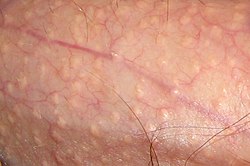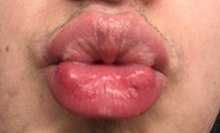Fordyce spots
| Fordyce spots | |
|---|---|
 Close-up of Fordyce spots on penis (shaft) | |
 Fordyce spots on vulva | |
| Anatomical terminology |
Fordyce spots (also termed Fordyce granules) are harmless and painless visible sebaceous glands typically appearing as white/yellow small bumps or spots on the inside of lips or cheeks, gums, or genitalia.[1][2] They are common,[3] and are present in around 80% of adults.[1] Treatment is generally not required and attempts to remove them typically result in pain and scarring.[3]
Their cause is unclear,
History
Fordyce spots are named after the American
Classification
Sebaceous glands are normal structures of the skin but may also be found ectopically in the mouth, where they are referred to as oral Fordyce granules or ectopic sebaceous glands. On the
When they appear on the penis, they are called penile sebaceous glands.[8]
Signs and symptoms
They appear as small, painless, raised, pale, red or white spots or bumps 1 to 3 mm in diameter that may appear on the scrotum, shaft of the
Description


On the shaft of the penis, Fordyce spots are more visible when the skin is stretched, and may only be noticeable during an erection.[8] The spots can also appear on the skin of the scrotum.[8]
Oral Fordyce granules appear as rice-like granules, white or yellow-white in color. They are painless papules (small bumps), about 1–3 mm in greatest dimension. The most common site is along the line between the
Occasionally, several adjacent glands will coalesce into a larger cauliflower-like cluster similar to sebaceous hyperplasia of the skin. In such an instance, it may be difficult to determine whether or not to diagnose the lesion as sebaceous hyperplasia or sebaceous adenoma. The distinction may be moot because both entities have the same treatment, although the adenoma has a greater growth potential. Sebaceous carcinoma of the oral cavity has been reported, presumably arising from Fordyce granules or hyperplastic foci of sebaceous glands.[citation needed]
In some persons with Fordyce spots, the glands express a thick, chalky discharge when squeezed.[8]
Causes
Normally, sebaceous glands are only found in association with a hair follicle.[citation needed]
They appear to be more obvious in people with oily skin types, with some
Diagnosis
Large numbers of lobules coalescing into a definitely elevated mass may be called benign sebaceous hyperplasia, and occasional small keratin-filled pseudocysts may be seen and must be differentiated from epidermoid cyst or dermoid cyst with sebaceous adnexa. The pathologist must be careful to differentiate such lesions from salivary neoplasms with sebaceous cells, such as sebaceous lymphadenoma and sebaceous carcinoma.
Oral Fordyce granules are usually not biopsied because they are readily diagnosed clinically, but they are often seen as incidental findings of mucosal biopsies of the buccal, labial and retromolar mucosa. The granules are similar to normal sebaceous glands of the skin but lack hair follicles and almost always lack a ductal communication with the surface. The glands are located just beneath the overlying epithelium and often produce a local elevation of the epithelium. Individual sebaceous cells are large, with central dark nuclei and abundant foamy cytoplasm.
Differential
Some diseases may appear similar to Fordyce spots such as sexually transmitted infections.[11]
Prognosis
Fordyce spots are completely benign[10] and require no treatment. They occur in 70 to 80 percent of adults.[12]
Epidemiology
They are present in around 80% of adults.[1] They are not usually visible in children, and tend to appear at about age 3, then increasing during puberty and become more obvious in later adulthood.[10] They are more prominent in males.[10]
References
- ^ a b c "Fordyce spots: Quick and Informative guidance — DermNet". dermnetnz.org. Retrieved 27 April 2023.
- ISBN 978-0-323-54753-6.
- ^ ISBN 978-3-319-99749-0.
- ISBN 978-1-84184-864-8.
- Who Named It?
- ^ derm/395 at eMedicine
- PMID 8849177.
- ^ PMID 23781523.
- ^ Palo Alto Medical Foundation Bettina McAdoo, M.D. Retrieved June 24, 2006.
- ^ ISBN 978-0-7020-4948-4.
- ^ "Fordyce spots". DermNet NZ (in Afrikaans). Retrieved 2019-12-21.
The importance of recognising these papules as Fordyce spots is in the differential diagnosis of other conditions that may appear similar. Some sexually transmitted diseases (STDs) may start off looking like Fordyce spots on the genitals so it is essential to get a proper diagnosis from your doctor. STDs need to be treated appropriately with medication.
- ^ "Fordyce Spots: Symptoms, Causes, Treatment & On Lips". Cleveland Clinic. Retrieved 2024-01-02.
